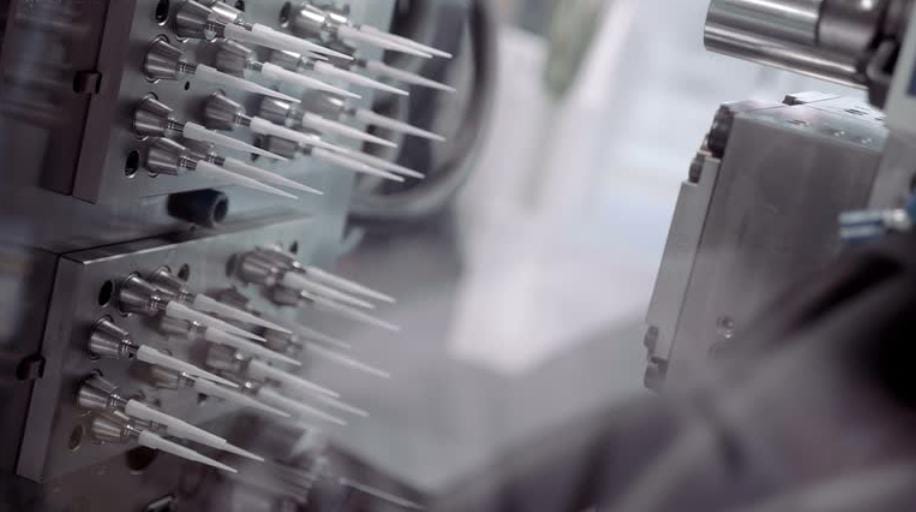Rapid Injection Molding: The Ultimate Guide
When comparing rapid injection molding to traditional methods, the most notable difference is in the cycle times. Traditional injection molding can take from several minutes to hours, or even days to produce parts, depending on the part’s complexity and size. In contrast, rapid injection molding is designed for shorter cycle times, often completing a cycle in just a few seconds, making it significantly faster than both CNC machining and 3D printing, which typically require several minutes per build at a minimum.
What is Rapid Injection Molding?
Rapid injection molding is a streamlined process used to produce parts in less time compared to traditional methods. It utilizes rapid tools that are less expensive and crafted from mold materials that may not be as durable as those used in high-end production molds like hardened steel. Typically, these molds can be prepared in a fraction of the time required for complex tools in traditional methods, where tooling times can extend up to eight weeks or longer.
The trade-offs include shorter tool life and part tolerances that might not match those achievable with high-volume molds. However, for many projects, especially those requiring shorter lead times or lower design complexity, rapid injection molds offer a viable solution. This method is particularly useful when speed in machine production is critical, making it essential in scenarios where quick development and iteration of parts are more beneficial than the durability of the molds used.
Injection Molding for Rapid Prototyping and Bridge Tooling
Rapid injection molding is pivotal for rapid prototyping and bridge tooling due to its speed and cost efficiency. This method allows designers to transition from prototypes to production volumes more quickly than traditional methods. By using injection molding resins, which are often less expensive than 3D printing resins or machinable plastics, it becomes a preferred choice. Additionally, a bridge tool provides a faster way to machine parts in moderate quantities when not ready for high part volumes that require a traditional injection mold. This approach significantly speeds up the development process and reduces costs, aligning perfectly with the needs of projects that must scale swiftly from prototype to production, utilizing techniques like insert injection molding.
Example of Rapid Prototyping Injection Molding
Alea Labs, a company specializing in smart HVAC systems, exemplifies how rapid injection molding can accelerate time-to-market. They needed to quickly produce plastic vents and grilles with complex designs involving many ribs at various angles. Traditional injection molding would have extended lead times to several months due to the intricacy. However, by opting for rapid prototyping, Alea Labs was able to reduce this to just a few weeks, significantly shortening their lead times and streamlining production.
Rapid Injection Molding Prototyping: Some Comparisons
Rapid injection molding excels in producing prototypes that require high design fidelity and specific tooling not easily achievable with 3D printing or CNC machining. This method allows for the creation of part samples through actual molding processes, essential when prototyping needs to closely mimic production. For instance, injection molding provides consistency for parts with complex geometries that 3D printing technologies may struggle to match. Additionally, using the final production resin during the prototyping phase helps in accurately evaluating the part’s functional performance.
In comparison, while CNC machines utilize cutting, milling, and drilling to refine designs, they often involve longer cycle times and higher costs when adapting tools for each new prototype, detailed in CNC machining cost analyses. 3D printing offers quicker turnaround times but may lack the necessary material properties for certain prototyping applications. Selecting the right partner with expertise in rapid injection molding can significantly shorten the development cycle, making it a superior choice for businesses looking to smoothly transition from prototyping to full-scale production.
Rapid vs. Traditional Injection Molding
Rapid injection mold tooling is primarily distinguished by its quick production of molds, facilitating faster transitions from part design to processing. This method uses materials that can withstand rapid heating and cooling, allowing for quick iterations of part samples unmatched by traditional methods. Although rapid tooling has a shorter lifespan than traditional molds, its balance of speed and part quality is highly advantageous for projects with tight deadlines or those in the early stages of market testing. Additionally, its ability to handle design complexity without extensive adjustments to machines or tool setups is a crucial advantage.
In contrast, traditional injection molds are suited for high-volume production, focusing on exacting tolerances and prolonged tool life. These molds, often made from durable metals, require longer lead times to manufacture. For businesses evaluating which molding process best fits their project requirements, understanding these key differences is essential. While traditional molds support large-scale production with consistent outputs, rapid tooling is ideal for dynamic projects where design flexibility and frequent design updates are prioritized. The scalability provided by mass production services complements the rapid prototyping capabilities, offering a comprehensive solution for various manufacturing needs.

